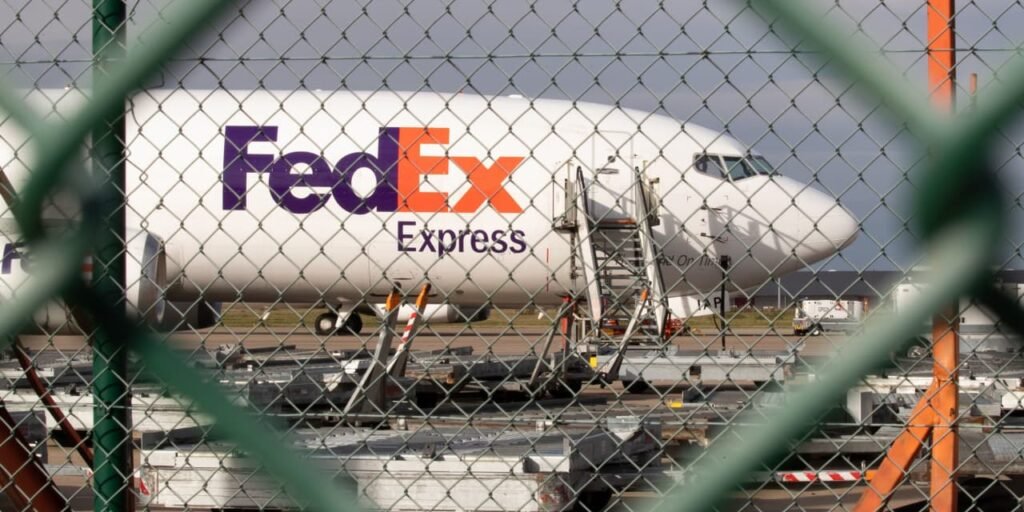FedEx stock was falling Wednesday as a downbeat revenue outlook took the air out of the delivery company’s rally. However, Wall Street analysts still see several reasons to back a turnaround plan that has driven the stock sharply higher over the past year.
FedEx
reported Tuesday fiscal second-quarter earnings per share of $3.99. Wall Street was looking for $4.19. It’s a miss. The company did maintain its full-year earnings per share guidance at a midpoint of $17.75. Sales, however, are expected to decline now. The prior forecast called for flat sales in fiscal 2024 compared with 2023. FedEx’s fiscal year ends in May.
Shares were down 9.5% to $253.31 in premarket trading after its second-quarter earnings report disappointed the market.
S&P 500
and
Dow Jones Industrial Average
futures were both down about 0.2%. The stock drop was set to wipe out a month’s worth of gains for the shares but FedEx came into the earnings report having risen 62% this year.
The impressive rally has been largely built on cost-cutting efforts. While FedEx’s lowered revenue guidance was a major disappointment, analysts still believe it is delivering when it comes to costs as it improved its operating profit margin to 6.4%, up more than 1 percentage point from the same period a year earlier.
“We believe that change is afoot post FedEx’s recent DRIVE event that provided visibility into key changes that are likely set to drive better margins, earnings, and FCF [free cash flow] in out years,” wrote Raymond James analyst Patrick Tyler Brown in a research note on Wednesday.
Brown also noted that FedEx could receive a boost to its freight business from the bankruptcy of delivery peer Yellow earlier this year. FedEx CEO Raj Subramaniam told analysts on an earnings call on Tuesday that the company had retained the majority of the market share it won from Yellow and rival
United Parcel Service
over the summer.
Brown lowered his target price on FedEx stock to $275 from $279 but kept his Buy rating on the stock. The target is based on an earnings multiple of 16 times FedEx’s forecast fiscal 2024 earnings per share.
One major concern for FedEx is the performance of its internationally focused Express business, which ships goods via air routes. Volumes there have continued to fall. The division’s operating margin came to 1.3% for the quarter, compared with 10.4% for the FedEx Ground division, which delivers items via trucks in the U.S. and Canada.
However, Citi analyst Christian Wetherbee said the Express results might be a product of cyclically low volumes hitting margins, meaning future results should improve.
“When the cycle turns (which may be happening now), we think leverage will return … We view any share-price pullback as a buying opportunity as we don’t think much has changed in the trajectory of earnings power through [fiscal] 2025,” Wetherbee wrote in a research note.
Wetherbee kept a target price of $300 on the stock and a Buy rating.
J.P. Morgan analyst Brian Ossenbeck has a Hold on the shares and cut his price target to $305 from $322 a share. He was thinking about UPS after FedEx reported its results.
“Read-throughs to UPS are mostly negative as FedEx continues to assert it is hanging onto the majority of share gains triggered by the Teamsters negotiation while also highlighting softer demand trends in U.S.,” wrote the analyst in a report Wednesday. “Overall, our view remains that both FedEx and UPS need to shrink over time as the fastest growing markets don’t fully utilize their legacy hub and spoke models.”
He also rates UPS stock Hold and has a $165 price target on the shares.
UPS stock was down 2.9% in premarket trading, while shares of logistics provider
XPO
were off 0.5%.
Overall, 45% of analysts covering UPS stock rate them a Buy. The average Buy-rating ratio for stocks in the S&P 500 is about 55%. About 61% of analysts covering FedEx stock rate shares Buy.
The average analyst price target for UPS stock is about $167 a share. It’s about $296 for FedEx stock.
Write to Adam Clark at adam.clark@barrons.com
Read the full article here
